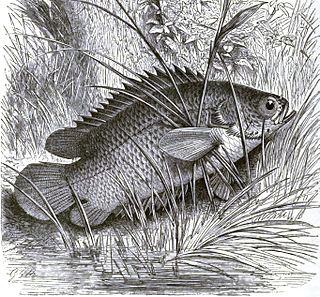
The Anabantidae are a family of ray-finned fish within the order Anabantiformes commonly called the climbing gouramies or climbing perches. The family includes about 34 species. As labyrinth fishes, they possess a labyrinth organ, a structure in the fish's head which allows it to breathe atmospheric oxygen. Fish of this family are commonly seen gulping at air at the surface of the water. The air is held in a structure called the suprabranchial chamber, where oxygen diffuses into the bloodstream via the respiratory epithelium covering the labyrinth organ. This therefore allows the fish to move small distances across land.

Channa bleheri is a species of dwarf snakehead that is endemic to the Brahmaputra River basin in the Indian states of Assam and Arunachal Pradesh. It is among the most colorful species of snakehead.
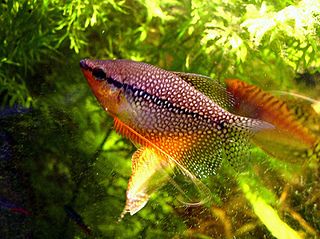
The pearl gourami is a species of gourami native to Southeast Asia.

Trichogaster is a genus of gouramis native to South Asia from Pakistan to Myanmar. It is the only genus in the monotypic subfamily Trichogastrinae as set out in the 5th Edition of Fishes of the World, although that book states that there are two genera, the other being Colisa which is treated as a synonym of Trichogaster by Fishbase and the Catalog of Fishes. Fishbase also places the genus in the Luciocephalinae. Species of this genus are very popular in the aquarium trade.

The ornate paradisefish or spotted gourami, is a species of gourami endemic to Sri Lanka. It is the only recognized species in its genus.
Microctenopoma damasi is a species of fish in the family Anabantidae. It is found in the Democratic Republic of the Congo and Uganda. Its natural habitat is rivers. This species was formally described in 1939 as Anabas damasi by the Belgian ichthyologist Max Poll, the type locality given was Semliki River at Ishango in the Democratic Republic of Congo. The type was collected by Hubert Damas (1910-1964) of the University of Liège and when he described the species Poll named Damas as co-author, this meant that Damas was the co-author of a specific name which honoured himself.

Microctenopoma is a genus of fish in the Anabantidae family. They are native to Africa. Microctenopoma has been included in Ctenopoma in the past; unlike that genus, they are bubblenest builders, and the males defend the eggs and fry until they are free swimming.

Betta enisae is a species of gourami endemic to the Kapuas River basin of Indonesia. It is an inhabitant of forest streams with slightly acidic waters, and can mostly be found in the shallows amongst the leaf litter. This species grows to a length of 5.9 cm (2.3 in). It is commonly used as bait by local fishermen and has been found in the aquarium trade. The specific name of this fish honours Enis Widjanarti who assisted Kottelat in his expedition to the Kapuas Lakes.

Betta edithae is a species of gourami endemic to Indonesia where it occurs in Kalimantan, Sumatra and the Riau Archipelago. This species grows to a length of 8.2 cm (3.2 in), and can be found in the aquarium trade. The specific name honours the German aquarist Edith Korthaus (1923-1987), who co-discovered this species with her husband Walter Foersch. Walter is honoured in the specific name of another species they discovered, Betta foerschi.
Betta foerschi is a species of gourami endemic to the island of Borneo, where it is only known from the southern portion. It inhabits creeks in the rain forest. This species grows to a length of 7 cm (2.8 in). It can be found in the aquarium trade. The specific name of this fish honours the German physician and aquarist Walter Foersch (1932-1993), who collected the type with his wife Edith Korthaus. Edith is honoured in the specific name of another species they discovered, Betta edithae.
Betta waseri is a species of gourami endemic to Peninsular Malaysia. It is an inhabitant of well shaded blackwater streams and in peat forests with plentiful organic debris and root growth. This species grows to a length of 9.8 centimetres (3.9 in) SL. The specific name honours the leader of the expedition on which the type of this species, the German aquarist Alfred Waser.

The Malay combtail is a species of gourami native to southeast Asia where it is found in peat swamps of the Malay Peninsula and the Greater Sunda Islands. This species can reach a length of 20 centimetres (7.9 in) SL. It is a commercially important species and is also found in the aquarium trade. This species was formally described by Georges Cuvier in 1831 with the type locality of Java. The collector of the type was collected in 1820 by the Dutch physician and biologist Johan Coenraad van Hasselt (1797-1823), whom Cuvier honoured in its specific name, with his friend Heinrich Kuhl.
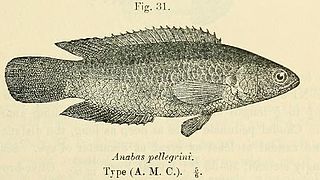
Ctenopoma pellegrini is a fish in the family Anabantidae found in the Congo River basin of Africa. It grows to 11.2 cm in total length for a male/unsexed specimen. This species was formally described by the British-Belgian ichthyologist George Albert Boulenger in 1902 with the type locality given as Yembe River at Banzyville in the Democratic Republic of Congo. Boulenger honoured the French ichthyologist Jacques Pellegrin (1873-1944).
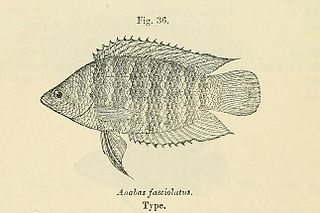
Microctenopoma fasciolatum or the banded bushfish is an Anabantoid fish of the genus Microctenopoma. It is native to the Republic of Congo, the Democratic Republic of Congo and a few rivers in Cameroon, occurring in the lower and central parts of the Congo River. This species has numerous irregular dark stripes running vertically across its body, with a horizontal lighter stripe separating them. The banding becomes more pronounced as the fish ages. In males, the dorsal and annal fins are more pointed, and - in some populations - have bright iridescent blue spots. This species, like many related anabantoids lays its approximately 1000 eggs into a bubble nest. This fish grows to a size of 9 cm (3.5 in).
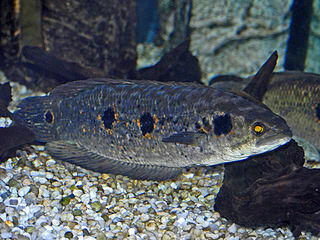
Channa pleurophthalma, the ocellated snakehead is a species of Southeast Asian freshwater fish in the snakehead family.
Channa stewartii is a species of dwarf snakehead in the family Channidae, which is native to Nepal and the Indian states of Arunachal Pradesh, Assam, Manipur, Meghalaya, Nagaland and Tripura. It may also be found in Bangladesh. This freshwater fish mostly inhabits hill streams, but can also be found in ponds. It is of little value as a food fish but common in the aquarium trade.
Trichopodus poptae is a species of ray-finned fish in the subfamily Luciocephalinae, part of the gourami family Osphronemidae. It is distinguished from its congeners by the faint, almost indiscernible patterning on the body apart from the black blotch at the base of the tail. This species is endemic to Kalimantan, the Indonesian part of the island of Borneo.

The licorice gourami is a species of freshwater ray-finned fish from the subfamily Macropodusinae, part of the family Osphronemidae, the gouramis. It is endemic to Bangka in Indonesia where it is found in the slow, flowing streams with black waters associated with peat swamp forests. This species was formally described by the Dutch ichthyologist Pieter Bleeker as Osphromenus deissneri in 1859 with the type locality given as Sungai Baturussa basin at 8 kilometres from Pudingbesar on the road to Kampong Simpan, Bangka. It is the type species of the genus Parosphromenus. The specific name honours F. H. Deissner, a military health officer, who sent a collection of specimens of fishes from Bangka to Bleeker which included the type of this species.

Pseudosphromenus dayi is a species of freshwater ray finned fish from the subfamily Macropodusinae, part of the gourami family Osphronemidae. It occurs in Kerala on both the coastal regions and the Western Ghats. It is a species of still or slow flowing waters, especially lakes, ditches and swamps in both fresh and brackish waters. Pseudosphromenus dayi is a bubble nester, the male creates a nest made of bubbles under an overhang or a leaf. The females lays eggs which drop to the substrate and are picked up by both fishes in the pair and placed in the bubble nest. The name Polyacanthus cupanus dayi was first published in 1908 by Köhler in 1908 but Catalog of Fishes refers to this as a nomen nudum and attributes the valid use of the name, with a formal description, to P. Engmann in 1909. The type locality is given as Malacca which is probably an error and should be Kerala. The specific name honors the British ichthyologist and author of the Fishes of India, Francis Day (1830–1889).

The threestripe gourami, also known as the Mekong croaking gourami, is a species of freshwater ray-finned fish from the subfamily Macropodusinae which is part of the gourami family Osphronemidae. It is native to south-east Asia.
















